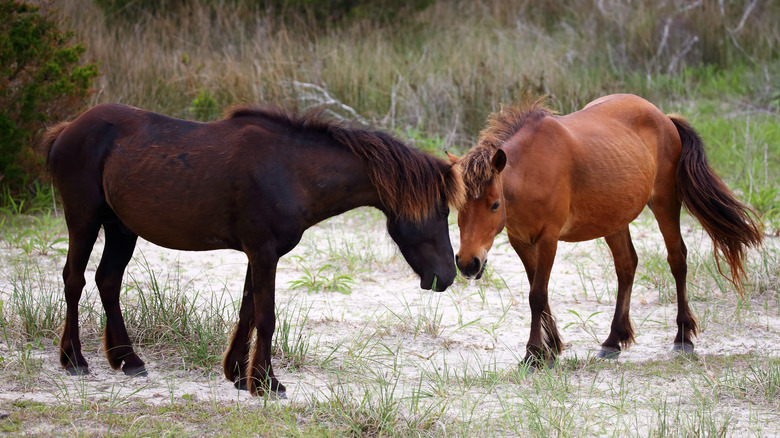The Secret Barrier Island In North Carolina With Wild Ponies, White Sand, And Clear Water
North Carolina's Crystal Coast hides a hidden gem that seems to have escaped time itself. Shackleford Banks, part of the Cape Lookout National Seashore, is a pristine barrier island that offers visitors a glimpse into an unspoiled natural world. This secluded paradise is known for its wild horses, expansive white sand beaches, and crystal-clear waters that beckon to adventurers and nature lovers alike. Need more convincing? Here are three reasons why you'll want to visit the Crystal Coast.
The history of Shackleford Banks is as rich as its ecosystem, with it taking its name from John Shackleford who acquired the island in 1713. Once home to a thriving community known as Diamond City, the island was gradually abandoned by 1902 due to the increasing threat of hurricanes and erosion. In the 1960s, Shackleford Banks found a new purpose as it was incorporated into the National Park Service, ensuring its preservation for future generations.
Stretching 8.5 miles long and approximately one mile wide, Shackleford Banks is a slender strip of land bordered by Back Sound to the north and the vast Atlantic Ocean to the south. This unique geographical position has created a diverse ecosystem that supports an array of wildlife, most famously its wild horses. Visitors to the island can not only bask in the allure of these majestic creatures but also in the excellent shelling opportunities and the chance to experience nature in its most untamed form. Whether you're seeking adventure, tranquility, or a connection with nature, this secret barrier island promises an experience that will linger in your memory long after the sand has been shaken from your shoes.
The wild horses of Shackleford Banks
While it might not be your first thought for the island where horses run free, the Banker Ponies of Shackleford Banks are the island's most famous residents. These hardy horses are believed to be descendants of Spanish Mustangs, possibly survivors of shipwrecks or abandoned by early explorers. Today, a herd of over 100 horses roams freely across the island, protected and managed by the National Park Service. These living legends offer visitors a rare opportunity to witness truly wild horses in their natural habitat.
Adapted to their coastal environment over centuries, the Shackleford horses have developed unique characteristics that allow them to thrive in this challenging landscape. They have learned to dig for freshwater and graze on marsh grasses. Their diet consists primarily of Spartina marsh grass, supplemented by sea oats and other vegetation found on the island. To ensure the horses' well-being and preserve the delicate island ecosystem, visitors are required to observe these magnificent animals from a safe distance of at least 50 feet.
For those eager to learn more about the island's equine inhabitants, the Cape Lookout National Seashore and National Park Service offer Horse Sense and Survival Tours. These guided excursions provide information about the horses' history, behavior, and the conservation efforts in place to protect them. Alternatively, many visitors opt for ferry rides around the island, which often offer excellent opportunities to spot the horses from the water. Regardless of how you choose to observe them, though, the wild horses of Shackleford Banks provide an unforgettable experience.
Exploring Shackleford Banks' natural beauty
Beyond its quadripedal residents, Shackleford Banks boasts some of the most pristine beaches along the Eastern Seaboard, with miles of unspoiled white sand stretching as far as the eye can see, lapped by clear, turquoise waters. The island is a shell-seeker's paradise, with a wide variety of shells deposited on the shores by the Atlantic currents. Lucky visitors might also spot other wildlife, including loggerhead turtles nesting on the beaches, various species of crabs scuttling along the sand, and numerous sea and shorebirds soaring overhead.
The untouched nature of Shackleford Banks also offers a wealth of activities for outdoor enthusiasts; swimming in the clear waters, hiking across the island's diverse terrain, kayaking in the sound, and fishing from the shore are all popular pastimes. However, it's important to note that the island's pristine state comes from a lack of modern amenities, and there are no facilities on Shackleford Banks, so visitors must come prepared with all necessary supplies, including water, food, and sun protection. This absence of development is precisely what allows visitors to experience the raw beauty of nature in its purest form.
Access to Shackleford Banks is primarily by ferry, with services running from nearby Beaufort, Harkers Island, and Morehead City. The island can be visited year-round, though each season offers something different, and it's the perfect place to spot tons of unique wildlife and escape crowds. Summer brings warm waters and abundant wildlife, while fall and spring offer milder temperatures and fewer crowds. Winter, though cooler, can be an excellent time for shelling and quiet contemplation. Regardless of when you visit, it's crucial to respect the island's delicate ecosystem by following all National Park Service rules, including proper waste disposal and maintaining a safe distance from wildlife.


